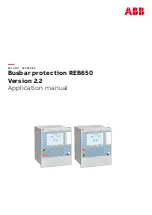
Current-source Analog Output Blocks
June 2002
GFK-0691D
2
Using this Datasheet ____________________________
This datasheet summarizes information about block installation,
configuration, and diagnostics.
Your primary reference should be the
Discrete and Analog Blocks
User’s Manual.
It includes detailed instructions for block installation
and configuration.
For additional information about systems and communications,
including bus specifications, refer to the
I/O System and
Communications Manual
.
Compatibility __________________________________
Current Source Input blocks require a phase B Hand-held Monitor
(IC66*HHM501H, version 4.5 or later) for configuration.
For an IC697 series PLC, the programming software must be
version 3.0 or later. Bus controller IC697BEM731C or later is
required.
For an IC600 series PLC, the CPU must be rev. 105 or later. For an
IC600 series “Plus” PLC, rev. 110 or later is required. The
programming software must be rel. 4.02 or later. These blocks are
compatible with bus controllers IC66*CCBB902 and 903. They are
not compatible with bus controllers IC66*CBB900 and 901.
For an IC550 series PLC, the CPU must be rev. 3.0 or later. The
programming software must be rel. 2.01 or later.
If a Bus Switching Module will be attached directly to the block, it
must be the 24/48 VDC version (IC66*BSM021).
Installation Instructions _________________________
Carefully inspect all shipping containers for damage. If any
equipment is damaged, notify the delivery service immediately. Save
the damaged shipping container for inspection by the delivery
service. After unpacking the equipment, record all serial numbers.
Save the shipping containers and packing material in case it is
necessary to transport or ship any part of the system.
Block Mounting
Genius I/O blocks are considered "open equipment" and therefore
must be installed within a protective enclosure. They should be
located in an area that is clean and free of airborne contaminants.
There should be adequate cooling airflow.
The block can be mounted right side up, or upside down. Leave at
least 2 inches of space between blocks. Mount the block by drilling
two screw or bolt holes for 8-32 hardware. Position the block so that
the notches in the upper and lower flanges line up with the mounting
holes. Mount the block using 8-32 screws. Use star washers to
provide ground integrity.
Grounding
The block’s mounting screws must not be used as the only means of
grounding the block. Connect the green ground screw on the block to a
reliable ground system using a short wire lead, minimum size AWG #12
(avg 3.3mm2 in cross-section).
Warning
If mounting screws do not make good ground connection and
the ground screw is not connected to a reliable ground, the
block is not grounded. Electrical shock hazard exists. Death or
personal injury may result.
Block Wiring __________________________________
Do not overtorque the terminal screws. Recommended torque for all
terminals is 6 in/lb (.678 N/M).
Serial Bus Wiring
Terminals 1 to 4 are for the serial bus. These terminals accept one
AWG #12 wire (avg 3.3mm
2
cross-section) or two AWG #14 wires
(each avg 2.1mm
2
in cross-section). The minimum recommended wire
size is AWG #22 (avg .36mm
2
in cross-section).
Terminals 1 - 4 can also accommodate spade or ring terminals up to
0.27 inch (6.85mm) wide with a minimum opening for a #6 screw, and up
to 0.20 inch (5.1mm) depth from the screw center to the back barrier.
Be sure unshielded wire ends are not longer than 2 inches (5 cm).
Using one of the cable types recommended in the
System and
Communications User’s Manual
, connect the serial bus to terminals 1- 4.
(If the block will control a Bus Switching Module, see below instead.)
1
2
3
4
SERIAL 1
SERIAL 2
SHIELD IN
SHIELD OUT
If the block is at either end of the bus, connect a terminating resistor of
the appropriate type (see the System and Communications User’s
Manual for details) across its Serial 1 and Serial 2 terminals.
Serial 1
Serial 2
Shield In
Shield Out
Start
of Bus
End
of Bus
Terminating
Resistor
Serial 1
Serial 2
Shield In
Shield Out
Terminating
Resistor
Connecting a Bus Switching Module
If the block will control a Bus Switching Module, install the BSM at
terminals 1-4, as shown on the next page. Connect the serial bus cables
to the BSM as described in the
Bus Switching Module datasheet.
Wire
either BSM pigtail wire to terminal 8 on the block, and the other to
terminal 9.






















